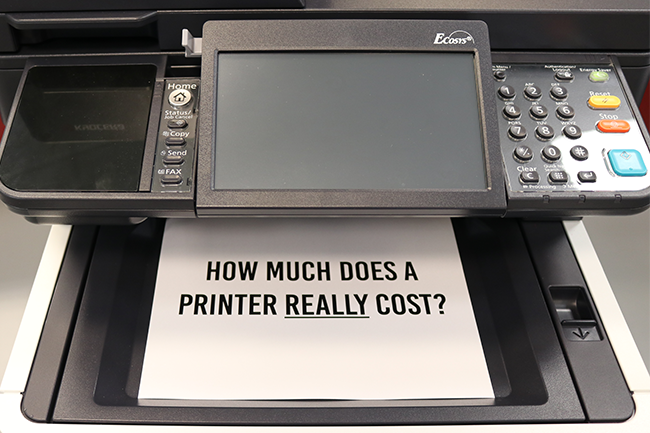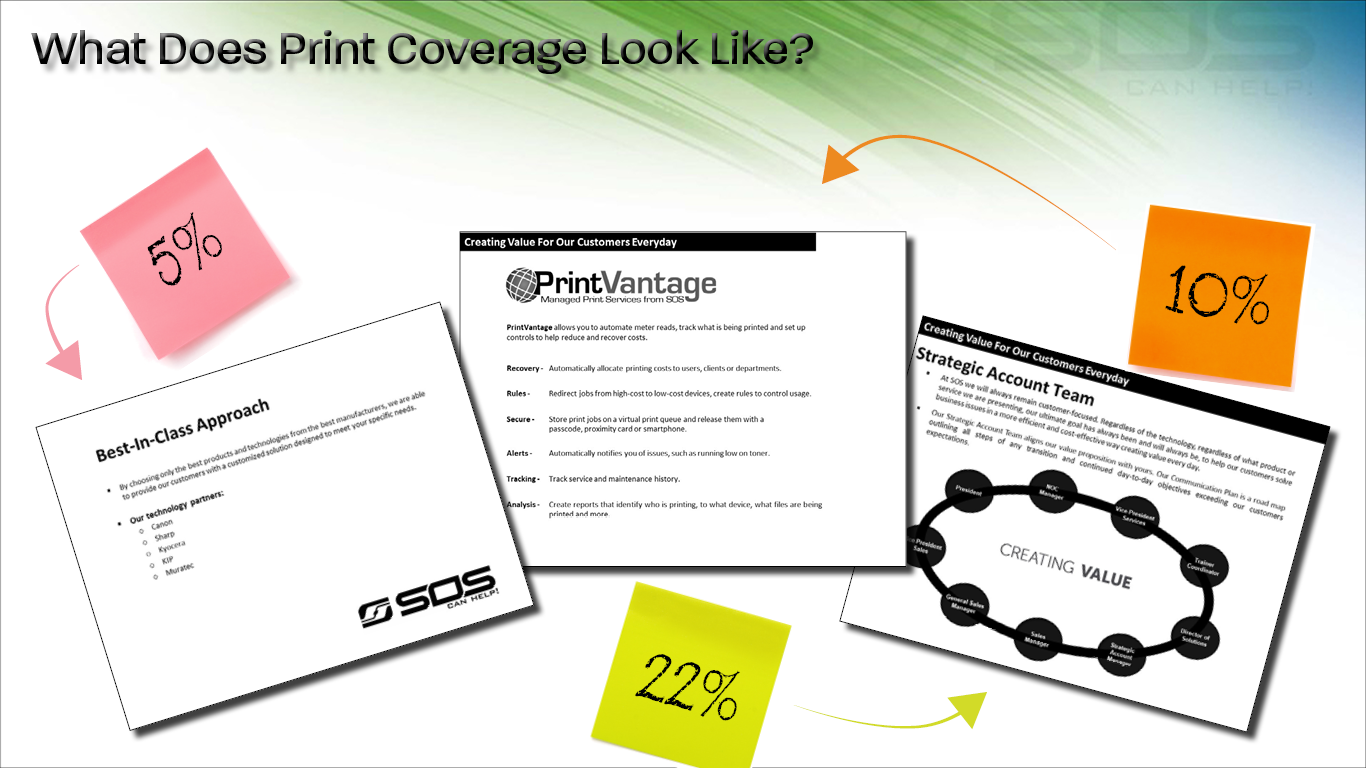
MANAGED PRINT SERVICES | 10 MIN READ
Printers can be very cheap. If you’re purchasing one for your home office, a standard inkjet printer may be all you need. Then again, if you're using printers for your business, they can get expensive very quickly if you don’t know what to consider when making your purchase.
In this article, I’m going to break down the actual costs of a desktop printer based on:
- Inkjet vs toner laser
- Volume
- Managed print services through a dealer vs managing it yourself
When you’re finished reading, you’ll be able to make a much more informed choice.
Not what you were looking for? Try: How Much Does A Copier Cost?
Not a lot of time? Skip to:
Cost of a Printer
The Difference Between Inkjet and Laser Printers
What’s the Best Value Printer?
Let’s first agree on the definition of value. Many people think value simply means, cheapest. But value is much more than saving a couple of bucks on the front end. If I purchase a car for $10, but it gets seven mpg, I’m not getting as good a deal if I need to drive 12,000 miles per year (the national average). That would mean my car would have to be filled up 123 times each year – assuming my car had a 14-gallon tank.
When you factor in the national average - when this article was written - of $2.86 per gallon, that brings us to $4,924.92 per year! If I compared that to a car getting 28 mpg (or $1,241.24 per year), that becomes a difference of $3,683.68 per year. If I keep my car for five years, that becomes a difference of $18,418.40! That means, if I didn’t purchase a car for more than $18,407.40, the more expensive car with the better gas mileage is the better option.
The point is, on the surface, anything can seem like a great deal if you only think about the sticker price. The cost to operate your purchase can change the game completely. Later in the article, I am going to break down the operating costs of a printer in the same manner that I just did with the car.
So, what’s the best value printer? To be able to decide that, we must look at the following considerations:
- Cost of a Printer
- Cost of the cartridges/refills
- Page per minute (ppm)
- Approximate volume printed per month or year
- Print coverage
- Cost of printer maintenance
Costs of a Printer
Printers run the full spectrum when it comes to cost. Printers sold online range from $12 - $8,000, retail. But why does such a vast range exist? If you thought, because of the features and capabilities, you would be correct.
Pages per minute, volume, ink or toner-based, connectivity, and color or black & white are some of the many considerations that affect a printer’s price. Name brands can also affect the cost of a printer.
Apple can sell their new iPhone at $1,000 when it hits the market because they know there will be a demand for their product. Their brand has built trust with its customer base.
If you took the same phone and slapped a different logo on it, it wouldn’t be able to sell for the same price. There are top brands in any market, and they all have the same effect on the price of products. The printer manufacturing business is no exception, but there are alternatives to the more common named brands (aka the HP printers of the world).
[Related]: Kyocera Printer vs HP Printers
The Difference Between Inkjet and Laser Printers
If you've ever had to buy a printer cartridge at a store or online, you’ve probably noticed the large range of pricing. Recently, I found an HP inkjet cartridge, branded for “economy printing.” The cartridge was only $15.29. That sounds like a deal! Unfortunately, the cartridge only allows for 180 pages (at 5% coverage).
As you can image, if you've any kind of normal printing that is done at home or in the office, this will not suffice. Now, if you're bound and determined to cut costs, there are options to purchase an ink tank and refill your cartridge yourself.
Canon sells a black ink tank for only 69 cents. But who really has time to sit there and refill ink cartridges on their own (not to mention the risk of making a mess)?
Ink cartridges are cheaper than laserjet at face value, but laserjet offers a longer lasting value. Plus, laserjet printing doesn’t have a smearing risk like inkjet printing does. For instance, an HP 12A black toner cartridge costs $7.85 for a 2,000 page yield. An HP 98 black ink cartridge that runs from $4.89, retail, only yields 420 pages.
Do the math. For the number of pages one toner cartridge will yield, you will spend $23.29, retail. And that’s before taxes. The fact is, toner cartridges and more efficient than ink cartridges, and efficiency creates value.
"But I don’t feel like I ever get the number of printed pages the box claims it can yield."
If you feel like your printer cartridge isn’t printing the quantity it claims, it’s probably because of a couple of things. Printer cartridges are based on a 5% page coverage ratio. Basically, if you don’t cover more than 5% of the page per page printed, you should be able to make it to or past the number that is claimed on the box. But what does 5% coverage look like. The image below shows an example of 5%, 10% and 22% coverage:

As you can see, 5% isn’t very much. How often do you print more than 5%? If you’re like most people, the answer is probably more often than not. It’s probably likely you're closer to the 10% mark, which means your cartridge (inkjet or laser) will last only half the amount of time indicated on the box.
You see, printer companies know that people are looking for a good deal on a printer. They also know that the value isn’t in selling you equipment, but in getting you to purchase their cartridges. After all, when was the last time you walked into an office supply store to purchase a printer and looked at what the cartridges cost before you bought the equipment? If you did – you’re ahead of the curve.
"But why do you keep saying retail?"
If you’re a business seeking a printer, a retail purchase online or at a big box store isn’t the only option. In fact, if you’re a business purchasing a set of printers, purchasing through a retail store is one of the worst investments you can make. The reason is because retails stores are designed to serve individual consumers, not businesses buying higher quantities. What if I told you could operate high-quality laser printers for a fraction of the price advertised online and in the stores?
Dealers like Standard Office Systems have greater buying power with manufacturers. As a result, they often get machines at a much lower price, but the real savings is in the cartridge refills.
Through managed print services, companies can potentially save a truckload of money if they have normal volume levels. Managed print services include all service, maintenance and refills for your printers. This means, you only pay a monthly rate that is easy to budget around.
READ: What Are Managed Print Services?
Imagine never having to go out to the store to purchase a refill again, never running out of refills, and never having to shell out a bunch of money for cartridge replacements. You also gain the peace of mind knowing that if your printer malfunctions, it’s fixed with one simple phone call.
If your printer broke right now, what would you do? Send it back to the manufacturer? Try to get an office big box store to fix it? Give up and simply purchase a new one? There are better solutions out there for businesses. You simply have to know where to look.
Want Learn More? Read:
How Much Does Printing Cost Per Page?
What Are Managed Print Services?
Kyocera vs HP Printers: Costs, Comparisons, and Considerations
Instant Benefits of Managed Print Services
How Much Does A Copier Cost?
Posted by Bernie Schom

Bernie Schom is the Vice President of Sales at Standard Office Systems and has been in the copier and printer industry for over three decades.

